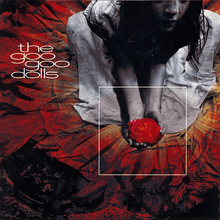Gutterflower
| Gutterflower | ||||
|---|---|---|---|---|
 | ||||
| Studio album by Goo Goo Dolls | ||||
| Released | April 9, 2002 | |||
| Recorded | August–December 2001 at Capitol Studios, Hollywood, CA, and House of Blues Studios, Encino, CA | |||
| Genre | Alternative rock | |||
| Length | 41:46 | |||
| Label | Warner Bros. | |||
| Producer | Goo Goo Dolls and Rob Cavallo | |||
| Goo Goo Dolls chronology | ||||
| ||||
| Singles from Gutterflower | ||||
|
||||
| Professional ratings | |
|---|---|
| Aggregate scores | |
| Source | Rating |
| Metacritic | 72/100[1] |
| Review scores | |
| Source | Rating |
| AbsolutePunk | (91%)[2] |
| Allmusic | |
| The A.V. Club | (average)[4] |
| Blender | |
| Entertainment Weekly | C+[5] |
| PopMatters | |
| Q | |
| Rock Hard (de) | (8/10)[7] |
| Rolling Stone | |
| Slant | |
Gutterflower is the seventh studio album by American rock band Goo Goo Dolls, released in 2002. It is the follow up to their critically successful albums Dizzy Up the Girl and A Boy Named Goo. The album was commercially successful upon its release, hitting #4 on the Billboard 200.
Track listing
All songs written by Johnny Rzeznik except when noted.
| No. | Title | Length | |
|---|---|---|---|
| 1. | "Big Machine" | 3:10 | |
| 2. | "Think About Me" | 3:59 | |
| 3. | "Here Is Gone" | 3:58 | |
| 4. | "You Never Know" (Robby Takac) | 3:08 | |
| 5. | "What a Scene" | 4:27 | |
| 6. | "Up, Up, Up" (Takac) | 2:58 | |
| 7. | "It's Over" | 3:36 | |
| 8. | "Sympathy" | 2:58 | |
| 9. | "What Do You Need?" | 3:49 | |
| 10. | "Smash" (Takac) | 2:27 | |
| 11. | "Tucked Away" (Takac) | 3:13 | |
| 12. | "Truth Is a Whisper" | 4:00 |
Song information
"Here Is Gone", "Big Machine" and "Sympathy" have been the only three songs released from this album as singles, and videos have been created for all three.
"Big Machine"
John Rzeznik refers to this as his "disco song". "I’m really horrible at programming drum machines, but this was like pattern 74 on my drum machine, which said 'disco.' I called all my friends and said, 'Check this out, this is my disco song!'" He describes it as "a propulsive tale of unrequited love". "Big Machine" was occasionally performed live on a smashed Stratocaster guitar that Rzeznik has fondly nicknamed "The Half-Caster". Despite being smashed in half, it still plays. It can be seen in a 2002 VH1 Storytellers special. Rzeznik stated that he had someone fix it up and it works just fine.
"Here is Gone"
John Rzeznik wrote this song on the phone while talking to a friend. He asked his friend if he should "take the chords up or take 'em down?" and the friend told him to "take 'em up" and that's how he came up with the chorus and the rest of the song came together shortly thereafter.
According to Rzeznik in 2007, the video for this song cost more to produce than the entire Gutterflower album itself.
Reception
In 2005, Gutterflower was ranked number 499 in Rock Hard magazine's book of The 500 Greatest Rock & Metal Albums of All Time.[10]
Personnel
- Johnny Rzeznik – lead guitar, lead vocals
- Robby Takac – bass, background vocals, lead vocals on "Smash", "Tucked Away", "You Never Know" and "Up, Up, Up"
- Mike Malinin – drums, percussion
Charts
Album
| Year | Chart | Position |
|---|---|---|
| 2002 | The Billboard 200 | 4 |
Single
| Year | Single | Chart | Position |
|---|---|---|---|
| 2002 | "Here Is Gone" | Billboard Adult Top 40 | 3 |
| 2002 | "Here Is Gone" | Billboard Modern Rock Tracks | 21 |
Certifications
| Organization | Level | Date |
|---|---|---|
| RIAA – U.S. | Gold | July 9, 2002 |
References
- ↑ 1.0 1.1 1.2 1.3 "Critic Reviews for Gutterflower". Metacritic. Retrieved May 1, 2012.
- ↑ "Goo Goo Dolls - Gutterflower - Album Review". AbsolutePunk.
- ↑ Erlewine, Stephen Thomas. "Gutterflower - The Goo Goo Dolls". Allmusic.
- ↑ Thompson, Stephen (April 9, 2002). "The Goo Goo Dolls: Gutterflower". The A.V. Club. Retrieved August 14, 2013.
- ↑ Farber, Jim (April 8, 2002). "Gutterflower Review". Entertainment Weekly.
- ↑ Ellis, Andrew (June 6, 2002). "Goo Goo Dolls: Gutterflower". PopMatters. Retrieved August 14, 2013.
- ↑ Schleutermann, Marcus. "Rock Hard". issue 181. Retrieved 21 May 2013.
- ↑ DeCurtis, Anthony (March 27, 2002). "Goo Goo Dolls: Gutterflower : Music Reviews". Rolling Stone. Archived from the original on May 9, 2006. Retrieved May 1, 2012.
- ↑ Cinquemani, Sal (April 6, 2002). "Goo Goo Dolls: Gutterflower". Slant. Retrieved August 14, 2013.
- ↑ [...], Rock Hard (Hrsg.). [Red.: Michael Rensen. Mitarb.: Götz Kühnemund] (2005). Best of Rock & Metal die 500 stärksten Scheiben aller Zeiten. Königswinter: Heel. p. 7. ISBN 3-89880-517-4.
External links
| ||||||||||||||||||||||||||||||||||||||